
Where Nx, Ny, Nxy are the in-plane force resultants, Mx, My,and Mxy are the moment resultants, Qx, Qy, are the transverse shear resultants.
The force and moment resultants are expressed as,

The elements of stiffness matrix [D],
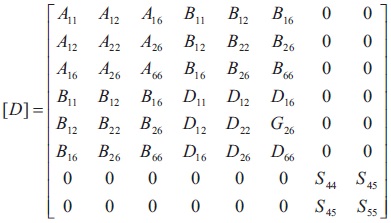
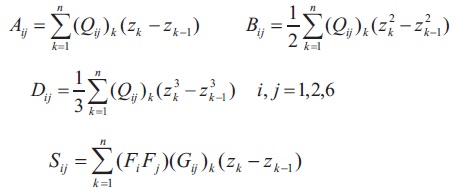
where Qij are the elements of elastic constant matrix


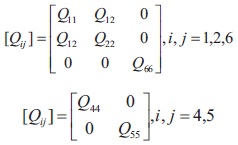
where,
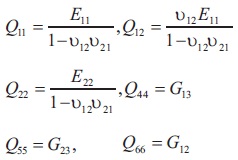
Fi and Fj are the two factors which is considered as one when the shell is thin. When the shell is moderately thick the product is considered as 5/6 as this is the shear correction factor from the theory of elasticity. Figure 1 shows the layers of lamina.

Figure 1. Layers of Lamina
The strain displacement relations of first order theory of shells,

where,
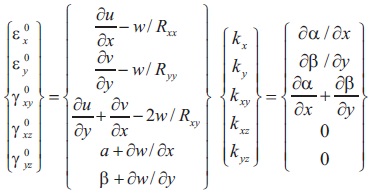
4.1 Finite Element Formulation for Shell
A six node curved quadratic orthotropic triangular finite element is used for shell analysis. Five degrees of freedom are defined at every node (u, v, w,α, β). The relations between the displacement with respect to ξ and η coordinates and degrees of freedom.
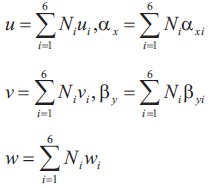
4.1.1 Shape Functions for the Six Node Triangular Element

Figure 2 explains how the node numbers are identified for each element. The encircled numbers show the element numbers. The numbers adjacent to the dots are the node numbers. For each element the node numbers are calculated in clockwise direction.

Figure 2. 2x2 with 6 Noded Triangular Element
The displacements of the elements can be expressed in terms of shape functions and nodal degrees of freedom.
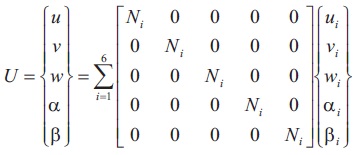
Stiffness matrix of the element will be solved by numerical integration method.
4.1.2 Stiffness Matrix for an Element
{ε}=[B]{δ}
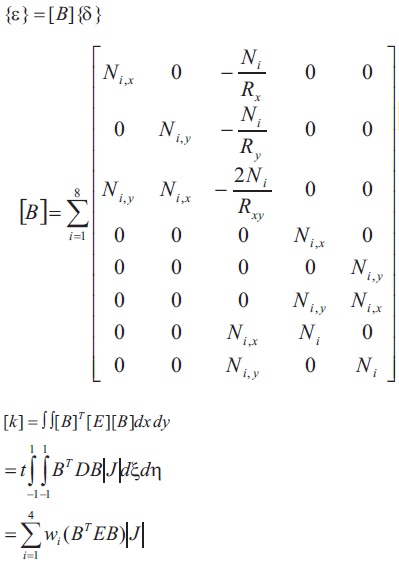

Stiffness matrix of the element will be solved by numerical integration method.
4.1.3 Hygro Thermal analysis (Université Libre de Bruxelles, n.d.)
Strain Tensor
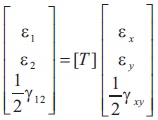


Thermal shear 

Similarly,
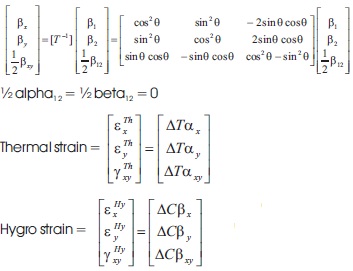
Total strain = Mechanical strain + thermal Strain + Hygro strain

The mechanical strain is given by,

The total strain is given as,

The stress is given as,

where (Shojaee et al., 2012),

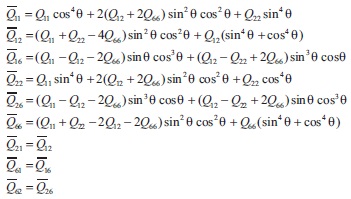
with,
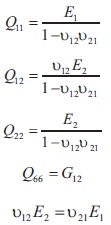
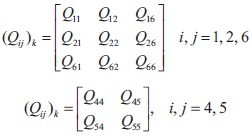
In the presence of external forces,
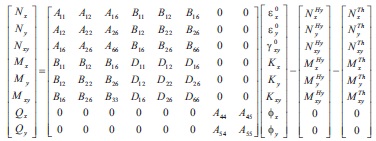
In the absence of external forces (Thai et al., 2013),


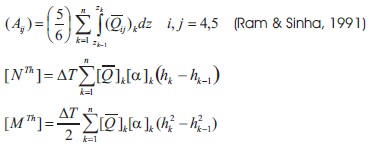
The element level stiffness matrix is given by (Ram & Sinha, 1991),

The element level nodal load vector due to mechanical forces is given as,

The element level nodal load vector due to hygrothermal forces is given as,

The solution for the nodal displacements is obtained from the equilibrium condition.

where KG is global stiffness matrix and UG is the global nodal displacement vector.
5. Problem Statement
To study the bending characteristics namely Displacement, Bending Moment, and Strain Energy for the following different problems.
- To perform a step by step analysis of SSSS plate having 0/90/0/90 lamina subjected to 1% change in moisture content.
- To analyze SSSS plate having 0/90/0/90 lamina for different aspect ratio subjected to different moisture content 0.25%, 0.5%, 0.75%, 1.0%, 1.25%, 1.5%.
6. Terms Used
6.1 Notations
The support notations are as shown in the Figure 3. The clamped support is shown in Figure 3a, in which the rotations and displacement is not allowed. The simply supported support is as shown in Figure 3b, where the rotations at the support are allowed.

Figure 3. Support Notations (a) Clamped (b) Simply Supported
6.2 Geometry
The size of the plate is 100 mm x 100 mm.
7. A step-by-step Analysis of SSSS Plate having 0/90/0/90 Lamina with 1.0% Change in Moisture Content
7.1 Input Data
The dimensions of the plate is 100 mm x 100 mm.
The thickness of the plate is 1 mm.
The Young's modulus of elasticity in direction 1 is
E11 = Exx = 130000 MPa.
The Young's modulus of elasticity in direction 2 is
E22 = Eyy = 8500 MPa.
The shear modulus of elasticity in direction 12 is
G12 = Gxy = 6000 MPa.
The shear modulus of elasticity in direction 13 is
G13 = Gxz = 6000 MPa.
The shear modulus of elasticity in direction 23 is
G23 = Gyz = 3000 Mpa.
The elastic moduli of graphite/epoxy is given in Table 1.

Table 1. Elastic Moduli of Graphite/Epoxy Lamina at Different Moisture Concentrations G13 = G12, G23 =0.5 G12, ᶹ12 =0.3, β1=0, β2=0.44
The Poisson's ratio ᶹ12 is equal to 0.3.
The number of divisions along x-axis (1 direction) is equal to 10.
The number of divisions along y-axis (2 direction) is equal to 10.
The mesh is made of 6 node linear strain triangular elements.
The number of Gauss points is equal to three.
The number of degrees of freedom per node is equal to five namely u, v, w, θx, θy.
The displacement conditions for nodes along x-axis at the boundary is 10110.
The displacement conditions for nodes along the y-axis at the boundary is 01101.
The displacement conditions for nodes at the four corners are 11111.
The value of β1 = 0 and β2= 0.44.
The change in moisture content is equal to
∆c = 1.0% = 0.01.
The total number of joints is equal to 441.
The total number of elements is equal to 400.
The size of the stiffness matrix is equal to the number of joints multiplied by degrees of freedom per node is
441*5 = 2205.
7.2 SSSS Plate having 0/90/0/90 Lamina
Step by step procedure to perform the hygroscopic analysis of laminated composite plate.
The six node triangular element is as shown in Figure 4.

Figure 4. Six Node Triangular Elements
The element node connectivity is given in Table 2 and the coordinates of the nodes are given in the Table 3.

Table 2. Showing the Element Node Connectivity Table

Table 3. The X, Y Node Coordinates
7.2.1 Shape Functions
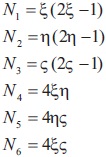
and 
Derivatives of the shape functions:
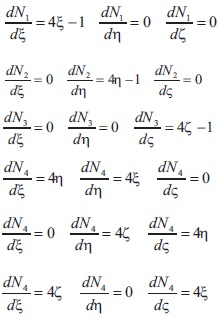
Jacobian of the element 1 is given at each Gauss point. Gauss points and their corresponding weights is given in Table 5.

Table 4. Gauss Points and their Corresponding Weights
Element 1 Gauss point 1

Element 1 Gauss point 2

Element 1 Gauss point 3

Element 2 Gauss point 1

Element 2 Gauss point 2

Element 2 Gauss point 3

7.2.2 Elasticity Matrix
Poisson ratio in the 2nd direction is Nu21 = Nu12 * E22/E11 = 1.96153846153846144E-002
The program segment used for calculating elasticity matrix developed using Fortran is listed.
Let,
AM = 1/(1-NU12*NU21) = 1.0059194490656556
QXX = E11*AM = 130769.52837853522
QYY = E22*AM = 8550.3153170580717
QXY = QXX * PRY = 2565.0945951174217
Let Z(1) = -(thickness)/2.0 = -0.50000000000000000
Z(2) = -0.25000000000000000
Z(3) = 0.0000000000000000
Z(4) = 0.25000000000000000
Z(5) = 0.50000000000000000
Laminae = 0/90/0/90
For theta = 0, K = 1
Let C1 = cos(theta)
S1 = sin(theta)
U1 = cos4(theta)
U2 = sin4(theta)
U3 = cos2(theta)*sin2(theta)
U4 = (C1*C1-S1*S1)*(C1*C1-S1*S1)
U5 = C1 * S1 * S1 * S1
U6 = C1 * C1* C1 * S1
Q(1,1)=U1*QXX+U2*QYY+2.*U3*(QXY+2.*GXY)
Q(1,2)=U3*(QXX+QYY-4.*GXY)+(U1+U2)*QXY
Q(1,3)=U6*QXX-U5*QYY+(U5-U6)*(QXY+2.*GXY)
Q(2,1)=Q(1,2)
Q(2,2)=U2*QXX+U1*QYY+2.*U3*(QXY+2.*GXY)
Q(2,3)=U5*QXX-U6*QYY+(U6-U5)*(QXY+2.*GXY)
Q(3,1)=Q(1,3)
Q(3,2)=Q(2,3)
Q(3,3)=U3*(QXX+QYY-2.*QXY)+U4*GXY
Q(4,4)=C1*C1*GXZ+S1*S1*GYZ
Q(4,5)=C1*S1*(GXZ-GYZ)
Q(5,4)=Q(4,5)
Q(5,5)=C1*C1*GYZ+S1*S1*GXZ
For I = 1 To 5
For J = 1 To 5
A(I,J)=A(I,J) + Q(I,J)*(Z(K+1)-Z(K))
B(I,J) = B(I,J) + Q(I,J) * (Z(K+1)**2-Z(K)**2)*0.5
D(I,J) = D(I,J) + Q(I,J) * (Z(K+1)**3-Z(K)**3)/3.0
Continue J
Continue I
The output of the calculated elasticity matrix is shown in Table 5.

Table 5. Elasticity Matrix for SSSS Plate having 0/90/0/90 Lamina
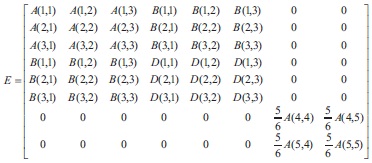
Hygroscopic loading has been analyzed using six node linear strain triangle, and the value at each node are calculated.
FH,1 = 24.45389
FH,2 = 24.45390
FH,3 = 8.324E-003
FH,4 = 1.64593
FH,5 = -1.64593
FH,6 = 1.040577E-003
Tables 6 hygroscopic load vector multiplied by strain displacement matrix respectively and subjected to change in moisture content of 1%.
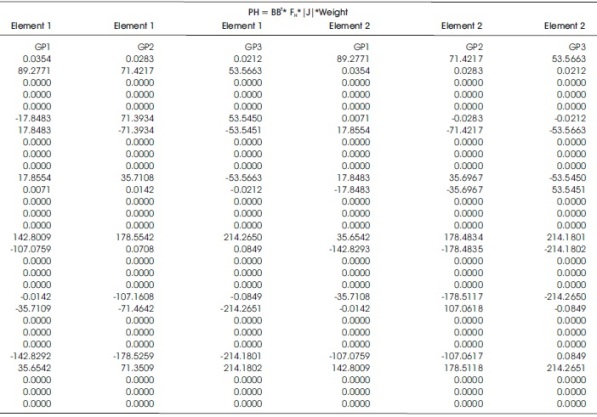
Table 6. Hygroscopic Load Vector Multiply with Strain Displacement Matrix
Assemble the global stiffness matrix and force vector and solve the simultaneous equations using Gauss elimination method. The maximum nodal z-displacement is equal to 0.0614321 mm at Node 214. The deformed shape due to change in moisture content of 1% is as shown in the Figure 5. The vertical deflections along the diagonal is nearly equal to zero.

Figure 5. The Deformed Shape (Magnified) of the SSSS Laminated Composite Plate Having 0/90/0/90 Lamina Using Six Node Triangular Elements with Change in Moisture Content of 1% (a) Deformed Shape of the Plate (b) Distribution of Strain Energ
Step wise procedure to calculate the nodal stresses are,
- The stresses in each element are calculated at the centroid of each element.
- The stresses are assumed to be constant throughout the element.
- All the six nodes of each element have same stress field.
- At each node, the stresses for each element having a node in common are averaged.
- The final nodal stress values are obtained by taking the nodal stress calculated above minus the hygroscopic force vector.
The nodal stress calculated using the centroidal stresses at each element are lower than the stresses calculated at the corners using the extrapolation method discussed in the literature. The moments Mx, My at the centre of the plate are equal and opposite. The Bending moment Mx, My, Mxy at the centre node 221 are found to be Mx = -7.3635 Mpa, My = 7.3635 MPa, Mxy = -0.00156 MPa. The moment Mx and My at the centre node 221 of the plate are equal in magnitude and opposite in sign. The moment resultant Mxy at the centre node 221 of the plate is equal to zero.
The vertical deflections along the centre line as shown in Figure 6 are plotted. Figure 7 shows the deflection curves of SSSS plate having 0/90/0/90 lamina along the centre line at different moisture contents. The maximum displacement occurs at the centre of the edge at an inner node N214 and N228. The moisture content is varied from 0.25% to 1.5% in steps of 0.25%. The deflection curves are parallel and non-intersecting for all moisture contents. The maximum deflection is observed when the moisture content is 1.5%

Figure 6. The Centre Line of Plate Along the Displacements Plotted

Figure 7. Graph Showing the Variation of Displacement on Y-axis and Node Number on X-axis for 100 mm x 100 mm, a/t =100 SSSS Laminated Composite Plate having 0/90/0/90 Lamina for Different Values of Moisture Content
Table 7 shows the vertical deflection at the nodes along the centre line of the SSSS laminated composite plate having 0/90/0/90 lamina at different values of moisture content. Table 8 shows the maximum deflection for different aspect ratios and moisture content varying from 0.25% to 1.5%.
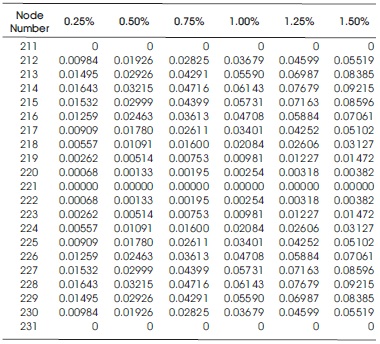
Table 7. Vertical Deflection in mm for Nodes along the Centre of the SSSS Composite Laminate Plate having 0/90/0/90 Lamina for Different Values of Moisture Content

Table 8. Maximum Vertical Displacement in mm at Node 214 for SSSS Laminated Composite Plate for Different Moisture Content and Side to Thickness Ratio (a/t) with 0/90/0/90 Lamina
The maximum displacement at the node increases with the increase in the aspect ratio and moisture content. The vertical displacement is higher for the SSSS plate when aspect ratio is 200 over the displacement calculated when the aspect ratio is 50. Similar pattern is observed at all moisture contents as shown in Figure 8, the lines are parallel and non-intersecting.
Conclusion
In this study, the Hygroscopic analysis of laminated composite plates and shells having different lamina nd with different boundary conditions is presented. The results of nodal displacements, and stresses along a section chosen are presented. A three dimensional image can solve this requirement to understand the behavior of the structure at each and every node. The interpretation of the results can be better and precise.
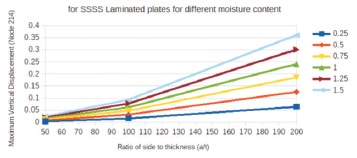
Figure 8. Variation of Maximum Displacement on y-axis and Side to Thickness Ratio on x-axis for SSSS Plate having 0/90/0/90 Lamina
The simply supported plate with lamina (0/90/0/90) subjected to hygroscopic loading has been analyzed using six node linear strain triangle. The results of the deformed shape of the structure show that the displacement is maximum near the centre of the edge. The displacement is zero at the centre of the plate and the displacement along the diagonals is also found to be zero. At the centre of the plate the moments are equal in magnitude and opposite in direction. The Strain Energy is maximum near the centre of the edges of the plate shown using the color band.
Future Study
The current study can be further carried as follows:
- Non-linear analysis can be performed to determine the bending characteristics.
- Vibrational analysis can be performed to determine the natural frequencies and mode shapes.